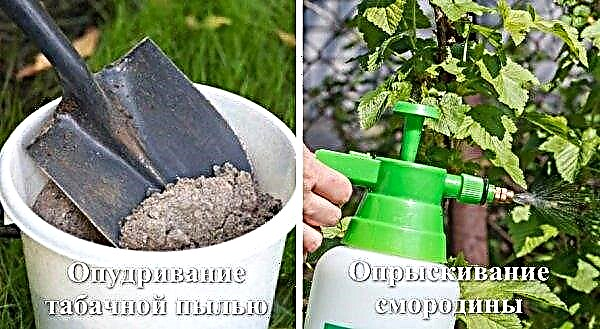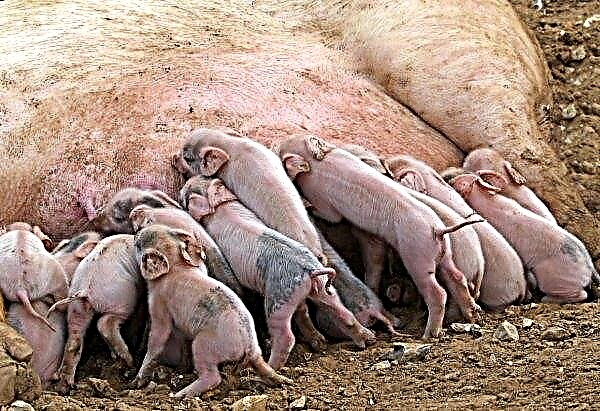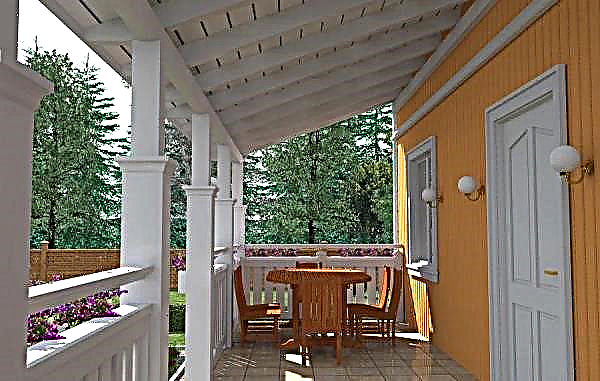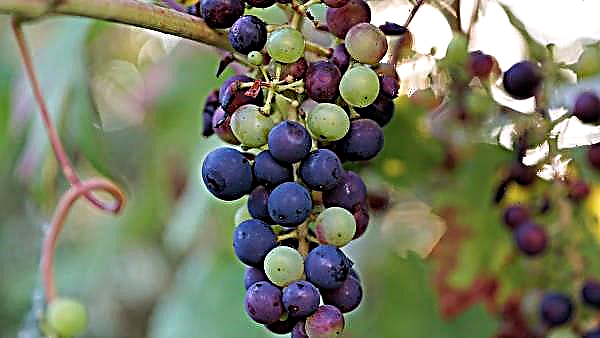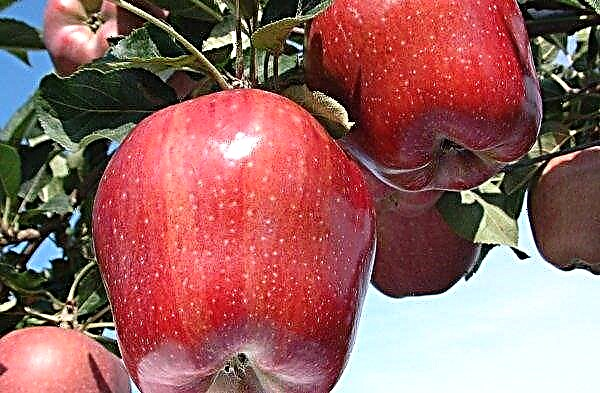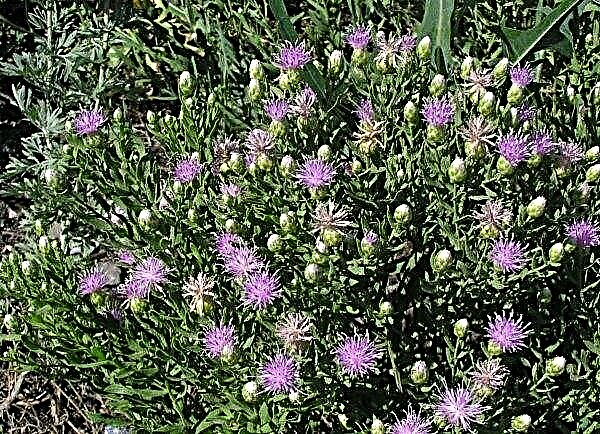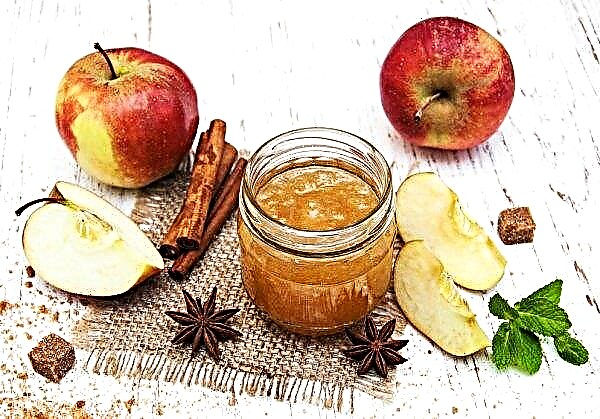Thuja is considered a frost-resistant crop. Among its many varieties, you can choose those that can grow up to the 2nd frost resistance zone with a minimum temperature of -45 ° C. From the article you will find out what arborvitae can grow in the Urals, about the conditions for their growth, the rules for planting and caring for them, and the features of reproduction.
Conditions for the growth of thuja in the Urals
The main parameter that is considered when deciding on the purchase of a tree is frost resistance. It is important for the gardener to know whether the plant can survive the winter safely. The Urals belongs to the 3-4th winter hardiness zones with minimum winter temperatures up to -34.5 ° С. This means that for landing you need to buy arborvitae, the marking of which will necessarily indicate the third zone.
Did you know? Thuja refers to those conifers, which pruning the top is good. If the tree is too stretched and bare sections of the trunk are obtained, then pruning will help redirect nutrients from growth to branch development.
If you purchase a variety for the 5th zone (minimum temperature -29 ° C), then for such a tree you will need to create a winter shelter. And be sure to grow it in a place protected from the wind. Over time, it may acclimatize and in the future will not need special measures. But with equal probability it can die. The next parameter is humidity. Thuja belong to evergreens. This means that they do not fall into a state of complete rest, like deciduous, so they are regularly watered throughout the growing season. In October - November, intensive irrigation is carried out to give needles the opportunity to stock up on moisture. These rules will remain the same for any region.
In October - November, intensive irrigation is carried out to give needles the opportunity to stock up on moisture. These rules will remain the same for any region.
Thuja can grow up healthy and attractive in a sunny area or in partial shade. The presence of a fully sunny area is important only for varieties with decorative (golden, silver) needles. It will be more pronounced when grown on such a site. When planting in the shadow of the needles will acquire a more pronounced green color.
Grade selection
The genus thuja consists of 5 species. In Russia, only one of them is represented as widely as possible - the western thuja (Thuja occidentalis), but if desired, other varieties can be ordered if the nursery delivers custom-made delivery. All varieties created on the basis of Thuja occidentalis can be grown in the 2nd – 7th winter hardiness zones. So, they are suitable for the Ural climate.

Western thuja itself is a large tree with a height of over 40 m. But for garden design, lower-growing varieties are used. Their height is 5–10 m.
Did you know? Thuja belongs to centenarians. It can grow for almost 800 years.
Among these may be noted:
- Variety Fastigiata (Fastigiata)represented by a slender 15-meter tree with a narrow conical crown.
- Smaragd - The most popular columnar thuja. It also grows over 15 m. The crown diameter reaches 5 m. The needles of Smaragda are bright green in the summer and do not lose their attractiveness in the winter.
- If you don’t like a strictly pyramidal crown, choose Columna. This tree is in the shape of a truncated cone with an expanded top. This variety is chosen for its external resemblance to cypress and the ability to give the surrounding landscape a Mediterranean style.

Gardeners who want to plant a tree of the same appearance, but of a smaller size can be advised to pay attention to other varieties.
Among these medium-sized varieties, it is worth noting:
- Justynka - a small tree of Polish selection. Its height by 10 years will be 1.2 m. The thuja is characterized by a columnar shape and dark green needles.
- Morgan - An Australian variety with a pyramidal crown 0.7–0.9 m high. The peculiarity of the tree is that in winter its needles will acquire a red-bronze color, and this is also unusually decorative.
- Diggroot Spire - The owner of a narrow-conical crown and bright green needles, which grows up to 2 m. In winter, its needles will acquire a light bronze hue.
- Brobeck's Tower - Another Polish variety. This is a narrow-conical green thuja 2 m tall.

For those who prefer golden needles, you can recommend the varieties of European Gold - 4-meter thuja with yellow needles with a slight orange tint, golden yellow Golden Brabant, Golden Smaragd, Amber (Jantar) and other varieties.
Important! Thuja branches can turn brown not only due to illness. This is a natural process of regulating the intake of nutrients and their consumption. Such shoots just need to be cut.
If you are going to choose a domed (spherical) form of a bush, then you will be suitable:
- Hoseri - a dwarf variety with a height of 0.8 m with green needles. As well as a similar Little Boy (Little Boy). It coincides in shade, but half in size.
- Miriam (Mirjam) - spherical shrub with golden needles.

Reproduction methods and their features in the Urals
Thuja reproduction is possible in two ways:
- planting cuttings;
- seeds.
The first one is convenient for gardeners. If the stalk is successfully rooted, then a plant is obtained that is identical to the one from which the branch was taken. For selection, the second method is used. Cuttings can be harvested from late summer to late autumn. But you need to remember that germination is a slow process, and in order for the shoots to develop into seedlings, it will take almost a year. Such planning allows you to grow enough seedlings to create a hedge.

To obtain seeds, female cones of one variety are pollinated with pollen of another. With successful pollination, cones will receive seeds bearing the characteristics of two parental varieties. This will be a kind of thuja, different from both of them. If the seeds were pollinated by pollen of the same tree in a natural way, then the seeds should produce plants of the same variety. Only grow to a real tree, they will be a little longer.
Did you know? Tuyu is considered a healing tree. It impregnates the air around with antimicrobial components - phytoncides.
Vegetative
Vegetative is a type of propagation in which a new plant is formed from part of the parent. In this case, this is cuttings. Before embarking on planting, you need to prepare planting material. To do this, you need a branch with a length of 15-20 cm. It must be completely healthy. At the top there should be signs of growth of the new season, and at the base - a strong lignified bark. The diameter of the branch is 5–8 mm. Cut it at an angle of 45 degrees. Lower needles are removed. At the base of the future seedling, the bark is gently poked. The cut site is treated with a growth stimulator in accordance with the instructions for the drug. Suitable "Kornevin", "Epin", "Athlete."
Video: propagation and cultivation of thuja by cuttings
A week before planting the cuttings, prepare a pot of soil mixture. Use garden sand. But you can also take soil disinfected with Fitosporin solution (5 g of the drug per bucket of water). The tool destroys phytopathogenic microflora, which is located in the soil. This should be done a week before landing. They also practice watering the soil with boiling water in order to destroy the larvae of pests that will be in the soil.
Did you know? In China, they believe that the branches of the thuja, if you bring them into the room, are able to expel evil spirits from there.
Planting a seedling itself is very simple:
- In soil mixtures, pencils make holes at a distance of at least 3 cm from each other and plant cuttings there. The depth of the hole is 15 mm. The angle of inclination is 45 degrees.
- The soil around the seedling is compacted.
- Spend abundant watering.
- Humidity must be constantly maintained at the same level. The top 3 cm of soil should be moistened.
- After 6 weeks, the seedling will form a root system. He will be ready to transplant into his own pot for further development.
- Such material can only be landed in the soil after a year.
 Cuttings are not suitable for only one type of coniferous - dwarf varieties, whose annual growth is 5 or less centimeters.
Cuttings are not suitable for only one type of coniferous - dwarf varieties, whose annual growth is 5 or less centimeters.
Generative
Generative is called reproduction by seeds or spores. For this, planting material needs to be collected. Thuja cones ripen in September. They look like small yellow-brown boxes. They need about 8.
The collected cones are placed in a paper bag and left to ripen in a sunny place. This process lasts 2-3 days. Then the seeds are shaken out of the seed boxes (cones). For germination they need a period of cold. So, the gardener will need to prepare peat moss and lay it in a plastic sealed container. Seeds are spread on top of the moss. They need to be slightly pressed into the peat, covered with a lid and put into the cold (0 ... + 2 ° C) before planting in the spring.
With the onset of spring, the container is pulled out. Peat cups or tablets are prepared. The latter are a very convenient form for seed germination. The tablet is moistened with water and the seeds are pressed into the surface.
Then, prepared tablets with seeds are placed in a container and placed on a sunny windowsill or in a greenhouse. After 2-3 weeks, the seeds will germinate to a height of 5-8 cm. But do not forget to keep the peat moist. After 2 weeks, rooted seedlings are transplanted into pots for further development. Soil composition: drainage layer at the bottom of the pot and peat or other nutrient mixture on top. Under such conditions, the seeds will grow throughout the year.Important! Do not use manure when planting thuja. Even in the overripe state, it contains a lot of nitrogen, which will burn the roots and can cause the death of the seedling.

Landing
Planting seedlings in open ground is planned for spring. To do this, you need to prepare the site. This should be an area with sufficient lighting - at least 6 hours of full sun daily. Soil must be drained. Its acidity does not matter, although thuja prefer slightly acid soil.
Landing time
Next spring, the time will come for planting sprouted young seedlings. Since the plant is still weak and tender, it is possible to plant it in the soil when the air temperature warms up to + 10 ° С. Before planting, be sure to harden the seedlings. To do this, take them out of the room onto the street every day for a week, increasing the time of stay every day.
Site preparation
The soil under the thuja should pass water well and be nutritious, so start by making sure its capacity. Dig a hole up to 60 cm deep, equal to the landing for an adult tree, and completely fill it with water. Wait for it to drain and pour a second time. If after 1-2 hours there will still be water in the pit, then during planting you need to make a drainage layer.
Soil quality also matters. Heavy clay soils contain no more than 5% organics, so they are diluted with sand for friability and garden soil or compost for nutrition. To plant a one-year-old seedling, you will need a bucket of compost.Important! Yellow needles in a seedling — a sign that it is drying up and has almost died. Such material is rejected.
Seedling Selection
If there is a lot of planting material, but not all of it suits you, just select those seedlings that will be the tallest. A good planting material has bright green needles. It has a straight trunk without damage and traces of disease. When extracted from the pot in which it grew, numerous and developed roots are found.

Step-by-step landing
For landing on a constant place of growth, landing pits are prepared. Their depth should be 2 times greater than the root ball, and the width should be 2–3. It is advisable to make the pit square. This will cause the roots to grow down, rather than bending in a circle, as during growth in a pot.
Thuja landing step by step:
- Mix the removed soil with compost if it is not nutritious, and with sand if it is very dense.
- Place drainage at the bottom of the pit if the soil is poorly leaking water. Layer thickness - 15 cm.
- Place prepared soil mixture on top.
- Remove the seedling from the pot.
- Lightly free the roots around the edges, but do not clear them of the soil in which it grew.
- Place the plant in the pit.
- Start to fall asleep with a mixture of soil.
- Compact the soil and water the tree with a bucket of water.
- Compact the soil.

Care Features
The thuja is unpretentious in service, and it is very simple to look after it. You do not have to spend a lot of time. In order to successfully grow, she will need:
| Month | Act |
| February | Sanitary and molding pruning. |
| March | The introduction of a shock dose of fertilizer. |
| April - September | Regular watering. |
| October | Intensive watering before wintering. |
| November | Preparing a tree for winter. |
Watering and feeding
The peculiarity of watering thuja is as follows: it tolerates moist soil well, but poorly waterlogged. Thuja is a very slow consumer of moisture, and if the water does not have a drain, then the roots will be constantly moist, which will end with their rotting and death of the tree.
For newly planted bushes, watering is organized more often - every 2-3 days. Water is poured so as to wet the root zone. Then the frequency of irrigation decreases - up to 1 time in 5 days. A layer of 7 cm mulch will also help maintain a more uniform soil moisture and temperature.
Video: Thuja care
When autumn comes, watering is stopped. But in October they definitely spend one plentiful. This is necessary in order to replenish the moisture reserves in the needles. In winter, evergreen crops do not freeze completely, and due to lack of moisture they may turn brown and fall needles.
In the spring, nitroammophoska (100 g per 5 l of water) is introduced under each tree, and in the fall, 50 g of superphosphate and 30 g of potassium nitrate. You don’t need to fertilize a small seedling, if you planted additional organic fertilizers during planting. In addition to them, part of the nutrients comes from the organic layer of mulch. Under the influence of moisture, it will decompose and additionally nourish the plant.Did you know? Tuyu is used to make perfumes. So, subtle notes of its aroma are present in bottles of such famous colognes as Hugo Boss and Ralph Lauren.
Loosening
Weeds appear everywhere. For a young plant with a poorly developed root system, they become competitors for water and nutrients, so they must be removed. Weeding is combined with soil loosening after irrigation or rain. Loose, it provides the best conditions for the development of roots. But if the near-trunk zone is covered with a layer of mulch, then loosening the earth is not necessary.

Pruning
The correct formation of the crown is to maintain the natural shape of your arborvitae, so the only regular type of pruning is sanitary. Spend it in March.
Did you know? The basics of molding trim were laid by the Romans. They were the first to coniferous shapes of geometric shapes.
Sanitary pruning step by step:
- Dip the cutting edges of the tools in boiling water for 30 seconds or wipe them with alcohol. If several trees are to be trimmed, repeat the procedure before starting work with the next tree.
- Remove dead and diseased branches. This will prevent rotting and the spread of disease. Cut them directly at the point of connection with the trunk and lubricate the cut with garden var.
- Trim those branches that grow inward and create a thickened crown.
- Also, do not forget to shake the showered dead needles from the inside of the tree during work.

Modern designers complement the tree with a metal frame and create a variety of forms. The simplest version of such a topiary is a spiral. You can make it from the pyramidal tree.
To do this, you will need:
- Wait for February. Although you can trim the thuja all year round, in winter the tree will not become infected with fungal microorganisms.
- Sanitize the instrument.
- Cut the main cone into secateurs. This is especially important for tall varieties.
- Fix the marking tape just below the top.
- Wrap it around the thuja in a spiral from top to bottom. The width of the step is chosen at the discretion of the gardener.
- Fasten the tape to the lower branch.
- Cut needles under it, moving from bottom to top.
- After the spiral formation is completed, cut the branches that interfere.
- Remove the tape. Inspect the tree and correct the shape if necessary.
- They keep fit throughout the year.
 Dwarf thujas are often given the appearance of animals. But if you're a beginner, then start with simple forms. This will protect the plant from excessive pruning, and the gardener from disappointment.
Dwarf thujas are often given the appearance of animals. But if you're a beginner, then start with simple forms. This will protect the plant from excessive pruning, and the gardener from disappointment.
Winter preparations
Thuja is frost-resistant, but a small tree can break under a mass of snow, especially if it is heavy watery snow, so gardeners for young thuja make a wooden frame in the shape of a cone and fit it with agrofibre in several layers. This will protect the plant from snow and from severe frost. For young thuja up to 2 years old, the material should be transparent so as not to impede the process of photosynthesis. But you need to install the frame when the temperature drops below 0 ° C.
If snow falls early in your area, it will protect the roots from frost. But where winters are snowless, it is necessary to cover the root zone of mulch. It will fulfill the role of an insulating layer, keep the soil temperature stable and prevent changes in its state when the thaw is suddenly replaced by frost.

Different varieties of arborvitae, both tall and dwarf, are suitable for growing in the Urals. Each of them has its own decorative features. But the requirements for growing conditions are the same for most varieties: moist fertile soil and a sunny area, so you should focus on what shape and size the tree needs for your garden composition.



